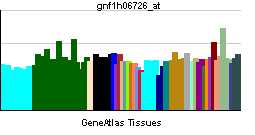HCN1
| Hyperpolarization activated cyclic nucleotide-gated potassium channel 1 | |||||||||||||
|---|---|---|---|---|---|---|---|---|---|---|---|---|---|
 PDB rendering based on 1q3e. | |||||||||||||
| |||||||||||||
| Identifiers | |||||||||||||
| Symbols | HCN1 ; BCNG-1; BCNG1; HAC-2 | ||||||||||||
| External IDs | Template:OMIM5 Template:MGI HomoloGene: 32093 | ||||||||||||
| |||||||||||||
| RNA expression pattern | |||||||||||||
 | |||||||||||||
| More reference expression data | |||||||||||||
| Orthologs | |||||||||||||
| Template:GNF Ortholog box | |||||||||||||
| Species | Human | Mouse | |||||||||||
| Entrez | n/a | n/a | |||||||||||
| Ensembl | n/a | n/a | |||||||||||
| UniProt | n/a | n/a | |||||||||||
| RefSeq (mRNA) | n/a | n/a | |||||||||||
| RefSeq (protein) | n/a | n/a | |||||||||||
| Location (UCSC) | n/a | n/a | |||||||||||
| PubMed search | n/a | n/a | |||||||||||
Hyperpolarization activated cyclic nucleotide-gated potassium channel 1, also known as HCN1, is a human gene.[1]
Hyperpolarization-activated cation channels of the HCN gene family, such as HCN1, contribute to spontaneous rhythmic activity in both heart and brain.[supplied by OMIM][1]
See also
References
Further reading
- Hofmann F, Biel M, Kaupp UB (2006). "International Union of Pharmacology. LI. Nomenclature and structure-function relationships of cyclic nucleotide-regulated channels". Pharmacol. Rev. 57 (4): 455–62. doi:10.1124/pr.57.4.8. PMID 16382102.
- Bonaldo MF, Lennon G, Soares MB (1997). "Normalization and subtraction: two approaches to facilitate gene discovery". Genome Res. 6 (9): 791–806. PMID 8889548.
- Santoro B, Grant SG, Bartsch D, Kandel ER (1998). "Interactive cloning with the SH3 domain of N-src identifies a new brain specific ion channel protein, with homology to eag and cyclic nucleotide-gated channels". Proc. Natl. Acad. Sci. U.S.A. 94 (26): 14815–20. PMID 9405696.
- Santoro B, Liu DT, Yao H; et al. (1998). "Identification of a gene encoding a hyperpolarization-activated pacemaker channel of brain". Cell. 93 (5): 717–29. PMID 9630217.
- Ludwig A, Zong X, Jeglitsch M; et al. (1998). "A family of hyperpolarization-activated mammalian cation channels". Nature. 393 (6685): 587–91. doi:10.1038/31255. PMID 9634236.
- Kleiderlein JJ, Nisson PE, Jessee J; et al. (1999). "CCG repeats in cDNAs from human brain". Hum. Genet. 103 (6): 666–73. PMID 9921901.
- Ulens C, Tytgat J (2001). "Functional heteromerization of HCN1 and HCN2 pacemaker channels". J. Biol. Chem. 276 (9): 6069–72. doi:10.1074/jbc.C000738200. PMID 11133998.
- Proenza C, Tran N, Angoli D; et al. (2002). "Different roles for the cyclic nucleotide binding domain and amino terminus in assembly and expression of hyperpolarization-activated, cyclic nucleotide-gated channels". J. Biol. Chem. 277 (33): 29634–42. doi:10.1074/jbc.M200504200. PMID 12034718.
- Chaplan SR, Guo HQ, Lee DH; et al. (2003). "Neuronal hyperpolarization-activated pacemaker channels drive neuropathic pain". J. Neurosci. 23 (4): 1169–78. PMID 12598605.
- Lesso H, Li RA (2003). "Helical secondary structure of the external S3-S4 linker of pacemaker (HCN) channels revealed by site-dependent perturbations of activation phenotype". J. Biol. Chem. 278 (25): 22290–7. doi:10.1074/jbc.M302466200. PMID 12668666.
- Bender RA, Soleymani SV, Brewster AL; et al. (2003). "Enhanced expression of a specific hyperpolarization-activated cyclic nucleotide-gated cation channel (HCN) in surviving dentate gyrus granule cells of human and experimental epileptic hippocampus". J. Neurosci. 23 (17): 6826–36. PMID 12890777.
- Much B, Wahl-Schott C, Zong X; et al. (2003). "Role of subunit heteromerization and N-linked glycosylation in the formation of functional hyperpolarization-activated cyclic nucleotide-gated channels". J. Biol. Chem. 278 (44): 43781–6. doi:10.1074/jbc.M306958200. PMID 12928435.
- Ota T, Suzuki Y, Nishikawa T; et al. (2004). "Complete sequencing and characterization of 21,243 full-length human cDNAs". Nat. Genet. 36 (1): 40–5. doi:10.1038/ng1285. PMID 14702039.
External links
- HCN1+protein,+human at the US National Library of Medicine Medical Subject Headings (MeSH)
| Stub icon | This membrane protein–related article is a stub. You can help Wikipedia by expanding it. |
This article incorporates text from the United States National Library of Medicine, which is in the public domain.